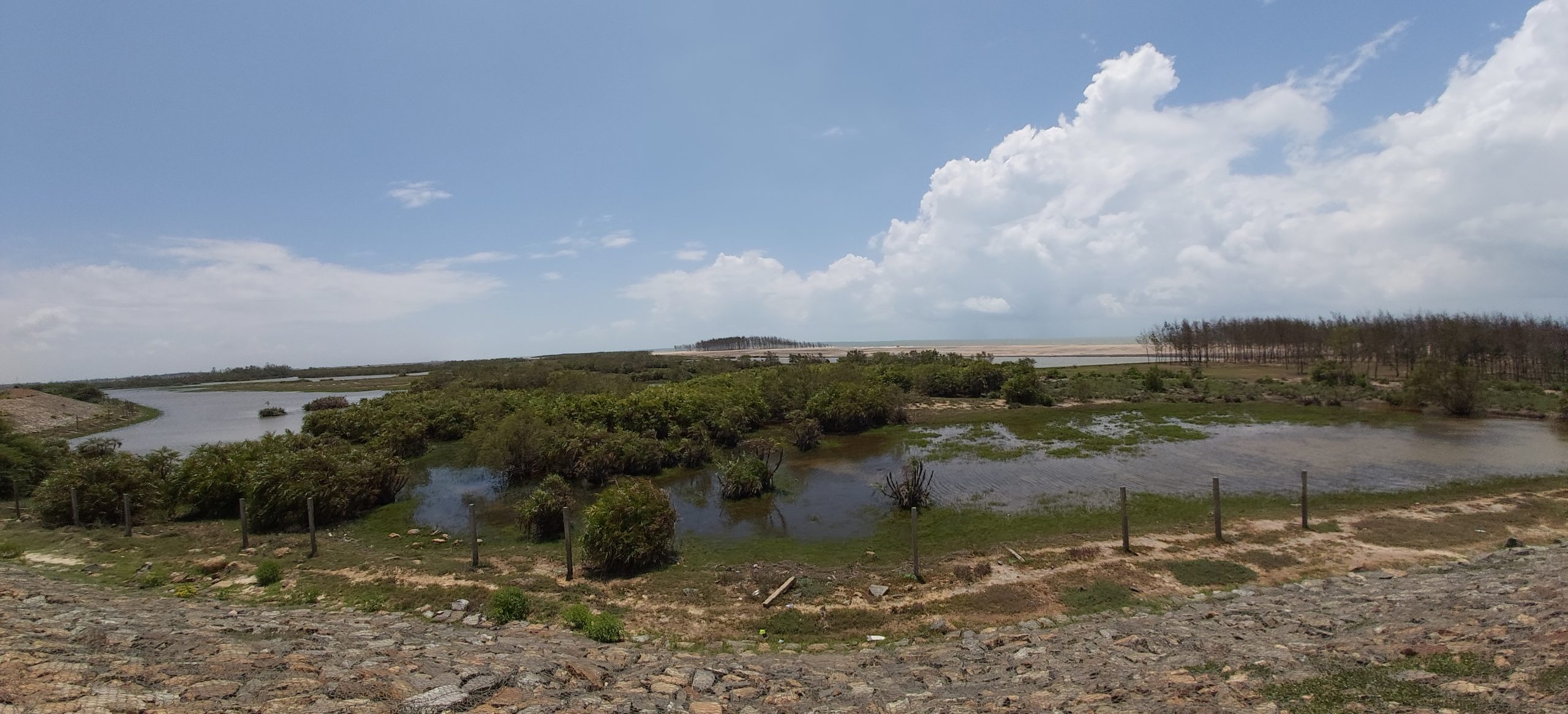By-Manish Kumar
- Villages on the east coast of India have been impacted by erosion by the sea over the last few years, with some of them being completely engulfed by the sea as well.
- In addition to recurring cyclones, human-made structures such as dams and ports have aggravated coastal erosion, say experts.
- Impacts of the erosion is also threatening the mangrove cover which is a natural deterrent against erosion. Geo-tubes, sea walls and other artificial measures provide only temporary relief.
Podampetta is a coastal village in the Ganjam district of Odisha. Few years ago had several households which were primarily involved in fishing trade. Now, in 2020, it has only five households. The rest of the village has been resettled by the state government to a new area called New Podampetta, around 300 metres away from the village on the eastern coast of India.
The resettlement of the entire village was triggered by the massive coastal erosion the village witnessed in the last few years. The village lies along the Bay of Bengal, now at a distance of only 50 metres from the sea. Several houses there have been damaged by natural disasters and are now lying in dilapidated conditions.
“Several houses in my village were damaged due to coastal erosion. The sea which was around 500 metres away from our village is now only around 50 metres away now. Due to high tides and strong waves, the village has seen severe damages while much of the beach has been engulfed by the ocean in the last few years,” said Gyan Bohrai, a resident of the village.
Around 15 kilometers away from Podampetta, there is another village named Arayapalli where one can spot the massive damages erosion has caused over the last few years. Arayapalli is within a kilometre north of a minor port where a breakwater has also been constructed in the sea, to prevent erosion.

A Telugu-speaking fishing community had been living in this area and relying mostly on fishing activities.
“After the port came into existence, the levels of coastal erosion have increased. They also constructed a long breakwater into the sea. In the last 10 years, the sea erosion in this area had been severe. The government tried to put some rocks at the coast to arrest the erosion but in vain,” said Madhu Trinath, a fisherman from Arayapalli.
Besides these two villages of Ganjam district that have been impacted by erosion, several villages in other five coastal districts of Odisha have seen massive destruction with some even fully engulfed into the Bay of Bengal. Recently, thousands of people from vulnerable areas in the state have been resettled to other safer villages.
Erosion-triggered displacement
Ranjan Panda, a climate change expert from the state and convenor of Water Initiatives terms the resettled population as “climate refugees” where the original inhabitants of a region are made refugees because of climate-induced causes. He cited the example of Satabhaya village in Kendrapara district where six villages were completely submerged into the sea and the villagers were later shifted to other areas. He attributed climate change as well as human interference in coastal areas as prime reasons for aggravating coastal erosion.
Panda also pointed out that mangrove plantations, which act as a natural deterrent to sea erosion, were shrinking. “Coastal erosion cannot be tackled unless you take care of rivers and mangrove plantations. Low sedimentation from rivers to sea due to dams, shrimp cultivation in mangrove plantation areas, climate change and other human activities have triggered loss of mangroves,” he said, adding that the mangrove belt, now under threat, is a natural deterrent to sea erosion.

Odisha is home to one major port at Paradip and several minor ports also exist along the coast. Notwithstanding the threat from erosion, the government is also attempting to boost tourism to the state’s beaches.
Neighbouring Andhra Pradesh faces coastal erosion too
Similar to Odisha’s situation, in the neighbouring state of Andhra Pradesh, the Uppada panchayat has seen the worst damages due to coastal erosion. Residents of several of its villages have been displaced due to the ingress of sea into the land owing to coastal erosion, leaving behind broken houses and damaged properties.
“Five villages in the Uppada panchayat have been completely resettled – around 3,000 people have been shifted from their original place of habitation. In the last few years the sea has moved almost 2.5 kms into the land. We have personally seen several houses getting uprooted and local properties being damaged due to the erosion,” said Chokka Prasad, a resident of Uppada.
According to the villagers of Uppada, the government attempted to arrest the effect of sea erosion by the construction of synthetic geo tubes on the beach where large bags of sand are covered with heavy rocks and tied together and placed at the beach to prevent further loss by erosion.
According to Prasad though, while this helped in the initial days, the barrier itself has been damaged as it has also eroded and been engulfed by the sea. The East Godavari and West Godavari districts of Andhra Pradesh have also witnessed erosion and experts attribute it to increased human activities and construction along the coast.

Rama Subramanyam, Principal Coordinator, M.S. Swaminathan Research Foundation, Machillipatnam said the deep water ports and other human-made obstructions aggravate erosion. He also talked about the demand for other preventive measures beyond geo tubes. Experiments of geo-tubes are also done in Odisha, Tamil Nadu and other areas.
“Geo tubes are expensive but the rate of erosion has come down but not stopped. But now it seems to be laid again due to damages. It demands quite an expense. The structures are slowly going to be under the sea. So people are now demanding other options like beach nourishment and others where sedimentation from outside could be used to boost the beach,” he said.

Others have also raised apprehensions about the utility of sea walls and geo tubes. “I don’t think this to be a good idea to counter erosion. These structures are likely to be taken back by the sea soon. Instead of construction on beaches, you need to explore the opportunities of off shore barriers where the waves are made. These have been utilised in places like Kaikee beach in Japan and in some places in Sri Lanka too and proved as a better option. These not only prevent erosion but boosts deposition,” said K Nageswar Rao, Professor (Emeritus) at the Department of Geo-Engineering in Andhra University.
Rao also said that the increase in construction of dams has added to the problem. “Rivers bring sedimentation with them towards sea to nurture the beaches. Dams affect the free flow of sediments towards the sea and affect the natural process of sea nourishment. Moreover, the mangrove plants which act as a buffer zone for beaches also need a combination of sea water and fresh water to grow but lack of incoming of fresh water and sediments can affect growth of the buffer zone along beaches,” said Rao.
Eastern coast more prone to erosion
The southernmost part of the eastern coast, Tamil Nadu, has also witnessed erosion by the sea. The state has two major ports, at Chennai and Thoothukudi, and 13 coastal districts. According to the 2018 report of the National Centre for Coastal Research (NCCR), Chennai, 41 percent of the coast in Tamil Nadu has eroded between 1990 and 2016.
Several coastal areas of the state like Thiruvottiyur, Oyalilkuppam, Periyakuppam and others faced coastal erosion. In the neighbouring Union Territory of Puducherry, 57 percent of the coastline has been eroded between 1990 and 2016, as per the same study. Experts in Tamil Nadu claim that in terms of geomorphology, the eastern coasts are different from western coasts and more prone to erosion and need better conservation and more attention.
“We have more erosion of the coasts in eastern India than in western India. In western India the coasts are mixed with rocky areas that protect them from erosion. In eastern India we have more plain and long beaches.” S. Srinivalu, former director of Institute of Ocean Management (ION), Anna University said.
Mary Divya Suganya from the National Centre for Sustainable Coastal Management (NCSCM), Chennai also said that human constructions along the beaches often are linked to aggravating the risk of coastal erosion.
According to a 2018 national study of the Indian shoreline, human activities particularly urbanisation and economic activities in coastal areas turned coastal erosion into a problem of growing intensity. It claimed that man made (anthropological) effects like construction of coastal structures, mining of beach sand, offshore dredging and dams on rivers are prime reasons for triggering erosion.
Meanwhile, several severe and minor cyclonic storms entering into eastern Indian coasts, experts have said, added to sea erosion as they damaged the mangrove and other green belt with large sedimentations as well as caused other damage to beaches.
New constructions in coastal areas governed by CRZ 2019 notification
According to a written reply given by the Dr Harsh Vardhan, Minister for Ministry of Science and Technology in Lok Sabha, the government has identified 98 coastal erosion hotspots in 11 coastal states/UTs.
“The Ministry of Environment Forest & Climate Change has issued the Coastal Regulation Zone (CRZ) 2019 notification with a view to conserve and protect the unique environment of the coastal stretches and marine areas, besides livelihood security to the fisher communities and other local communities in the coastal areas. The new constructions in coastal areas are being governed by this notification,” the minister had said in the Parliament in his response to query on sea erosion threats.
According to the National Centre for Coastal Research (NCCR) which analysed the data of 6632 km of the mainland coastline for 26 years (1990-2016), about 2247 km (34%) of mainland coast is under varying degree of erosion ranging from low, moderate and high.
Another response from Babul Supriyo, Minister of State for Environment, Forest and Climate Change made in Lok Sabha on December 2019 claimed that initiatives like mangrove plantation of about 16000 ha, shelter belt plantation of 1900 ha and installation of Geo-Tubes in 500 m have been taken up with a cost of Rs 86 crores.
However the government is at the same time planning to boost the major and minor ports along Indian coasts for the ambitious Sagarmala project and also planning to construct coastal highways.
The story was first published in Mongabay India. Read the original story here.









